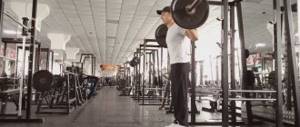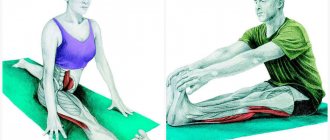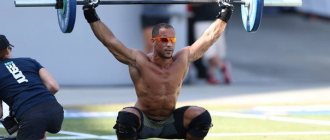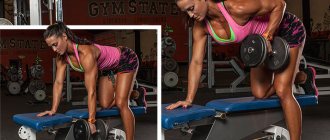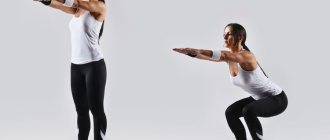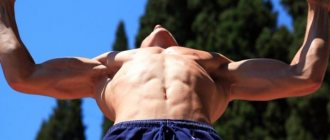- July 10, 2018
- Home workouts
- Tatiana Udalova
Lateral lunges are an effective way to work the muscles of the lower body. They can be performed using a barbell, dumbbells or with your own body weight. Side-to-side movements are used in most non-linear sports such as basketball, tennis, baseball and football. Incorporating lateral lunges into your workout will complement more traditional leg exercises such as squats, deadlifts, and classic lunges.
Working muscle groups
First, let’s find out which muscles work when lunging to the side.
- Side lunges mostly target the gluteus maximus muscles. Additionally, the smaller but equally important gluteus medius and minimus muscles are also involved. Make sure you perform the same number of reps on each leg to work both sides equally and avoid muscle imbalance.
- The hamstrings work together with your glutes to control the hip of your lead leg. There are three muscles that make up the hamstrings: the biceps femoris, semimembranosus, and semitendinosus. They help you control the movement into the lunge position and then help you rotate back into the starting position.
- The quadriceps femoris muscles are responsible for moving the knees. As with the hamstrings, as you shift your body weight to your lead leg, the quadriceps work to control the movement into the lunge position and then push you upright and back to the starting position. Towards the end of the set, you will likely feel that your quadriceps muscles are tired, and they may even shake with fatigue.
- Side lunges add additional stress to the adductor muscles, which are located on the inner thighs. While the adductors on your lead leg work the quadriceps muscles to control the movement of your knees and hips, the adductors on your other leg, which remains straight, get a good stretch.
Inclusion in the program
Lateral lunges are included in various types of programs from cross-country to powerlifting. If the goal is to harmoniously work the muscles of the thighs and buttocks for aesthetics, it makes sense to include the movement in your workout with Romanian deadlifts and glute bridges rather than squats.
Working out the hips and buttocks with this movement can occur either in an average number of repetitions or in repetitions up to 20 times.
If the goal is to warm up for deadlifts, then you should stick to a medium number of reps. Otherwise there will not be enough strength for traction.
For running and developing legs in running disciplines, you can use this movement as the only independent exercise, that is, perform 10-20 repetitions of 3-4 approaches at the beginning of preparation for general physical training.
Side lunges usually cannot be the main exercise in strength training.
Benefits of Exercise
There are many reasons why you should include lateral lunges in your regular workout routine. Below are some of them:
- Working out the outer thighs. There are so many leg exercises, including dozens of different types of squats and just as many lunges. Side lunges are unique in that they shape and tone the outer thighs. When nothing seems to work to eliminate those notorious thigh loops, try side lunges.
- Pumping the buttocks. Despite the fact that the movement is performed laterally, the body weight is mainly transferred to the gluteal muscles. Side lunges help tone and shape your butt.
- Heart training. Intense lateral movements also have side cardio benefits in the form of cardiovascular training. And if you add extra weight or resistance, you'll burn a tremendous amount of calories. Side lunges can burn about 100 calories for every 10 minutes of work.
- Improved balance and coordination. Because you move your body from side to side rather than the traditional back and forth, you add extra balance to the muscles around your hip and knee joints, which helps prevent possible future injuries. In addition to this, lateral lunges are good for your back as the lower body workout requires you to keep your back straight and chest up.
Contraindications
It is not recommended to perform exercises with inflammation of the hip and knee joints. Contrary to popular belief, they will not in any way affect the rehabilitation of this problem, but can significantly worsen the athlete’s condition. It is not recommended to plan movements unless there is an immediate ankle and foot injury.
Anyone who has no contraindications to squats can perform side lunges. If you have back problems, it is recommended to hold the weight in your hands rather than on your back.
Share link:
5 / 5 ( 1 voice )
Technique for performing exercises with your own weight
Now we will present information on how to correctly do lunges to the side with your own body weight.
- Stand with your knees slightly bent, feet shoulder-width apart, head and chest facing up. This will be your starting position.
- As you inhale, keeping your hands joined in front of you, lunge to the right. Extend your left knee, transferring your body weight to your right leg, which should be bent at the knee. Maintain good posture throughout your spine, supporting your head and chest.
- Pause at the bottom of the movement and then, as you exhale, push off with your working leg to return to a standing position. Move into a lunge on the opposite side.
- Do the recommended number of repetitions, alternating between working sides.
Useful tips
In order for side lunges to help effectively pump up your leg muscles, you need to listen to the following tips:
- when performing a side lunge, you need to straighten your back as much as possible, since the spine should be in a neutral position;
- the chest should be level and the shoulders should be straightened;
- when bending, the knees should in no case extend beyond the line of the big toes, as this is fraught with rapid wear of the kneecap and ligaments;
- body weight should be evenly distributed over the foot;
- at the beginning of the exercise, take a shallow breath, and at the end, exhale;
- Beginners should not perform the exercise without first stretching, and it is also not advisable to lift weights that are too heavy.
Correctly performed lunges with a barbell will help to train your leg muscles well.
To find out which leg muscles are used in crossover leg swings, go here: /silovye/s-nogi/vnutrennyaya-poverhnost-bedra/privedenie-nogi-v-krossovere.html.
Technique for performing exercises with additional weight
How to do side lunges with additional weight, namely dumbbells?
- Stand up straight, holding a pair of dumbbells on either side of your torso. Place your feet shoulder-width apart with your knees slightly bent.
- As you inhale, take a wide step with your right foot to the side without bending your left knee. Keep your left leg straight, chest facing up, back straight. Bend your right knee, push your hips back, and lower yourself down until your right thigh is parallel to the floor. The dumbbells should be on both sides of your right shin.
- As you exhale, return to the starting position, pushing off the floor with your heel.
- Do the recommended number of repetitions, alternating between working sides.
The benefits and harms of exercise
Barbell lunges provide many benefits to athletes. We offer you a list of the benefits of this exercise:
- improved coordination and balance,
- development of leg strength,
- pumping the muscles of the legs and buttocks,
- working out all groups of leg muscles, even hard-to-reach ones,
- increasing performance in other strength exercises for the legs,
- development of flexibility and mobility of hip joints,
- working out all the gluteal muscles,
- increase in the volume of the main muscles of the thighs, calves,
- strengthening the muscles of the back, abs,
- pumping the muscles of the arms and neck,
- training endurance, concentration and balance,
- relaxation of spinal tightness,
- increased blood circulation in the pelvic area,
- improving the functioning of internal organs.
Barbell lunges for men and women can cause serious harm to health if performed incorrectly. To avoid this, you need to work with optimal weight, increase it gradually and adhere to the technique of performing the exercise.
Weighted lunges put a lot of stress on the leg muscles, tendons, and knee joints. If you have injuries or problems with them, it is recommended to refrain from such exercises or replace them with ones that are more gentle on the joints.
The risk group for whom lunges are contraindicated also includes the following indicators:
- phlebeurysm,
- hypertension,
- chronic back diseases,
- hernias,
- recent operations,
- heart disease,
- pregnancy,
- various neuralgia.
Exercise options
Once you've mastered bodyweight lunges, add additional weights. Side lunges with a barbell or dumbbells are a great option for making the exercise more challenging. You can also use a resistance band to add extra resistance. And adding jumping jacks between lunges will enhance the cardio benefits of the exercise.
What do lunges do?
Side lunges are basic types of exercises that allow girls to work on the most problematic areas - the buttocks and inner thighs. With the correct technique, the work includes the oblique abdominal muscles, quadriceps, and spinal extensors. Depending on the intensity of hand work, more or less involvement of the shoulder girdle and back muscles occurs.
About training the gluteal muscles >>
The advantage of leg exercises is their simplicity and effectiveness. They are used to correct the breeches area, help to quickly remove fat deposits and increase muscle tone, making the figure slimmer and more toned. Lunges are considered universal exercises that are suitable for both beginners and girls with a sufficient level of physical fitness. They allow you to vary the load, which can be increased using a barbell, dumbbell or other types of weights.
Recommendations for performing the exercise
Below are some tips to help you do lateral lunges.
- A common mistake when doing lunges is that people often move their leg too wide and fail to align their shin over their foot, causing the knee to point inward. Simply shorten your stride so that you can straighten your foot with your knee pointing forward.
- Keep your core tight and engaged throughout the exercise.
- You'll get maximum glute work by focusing on pushing the weight through your heel, squeezing your glutes, and pushing yourself into the starting position.
- Perform lunges as controlled as possible. Using muscles to do the work, not impulse.
- Do the exercise in 3 basic sets of 20 reps on each side, or fewer reps (about 8-10) if you're doing lunges with additional weight.
Basic errors during execution
Incorrect weight
This is the most basic mistake that novice athletes often make. They think that heavy weight will allow them to develop their muscles faster. But the body is not yet ready for such stress. And the tendons and ligaments are not strong enough. Therefore, it is easy to injure them. To avoid this, you need to soberly assess your strengths. And select a weight with which you can perform the exercise technically correctly.
Rounding and tilting the back
This error most often occurs when working with dumbbells. Especially if they are located on the arms down. And under their weight, the back rounds. As a result, the center of gravity will shift. Which will create excessive stress on the spine. The same applies to strong forward bending. If you round your back with a barbell placed on it. Then she will jump down. And the consequences may not be the most favorable.
Step too long or short
The amplitude of movement and stability of position depend on the length of the step. If we put our working leg too far back with insufficient flexibility. Then, during a squat, in addition to pain in the groin area, the foot of the working leg will begin to lift off the floor. Because of this, we will lose our balance and fall. If we don’t move our leg far enough, we simply won’t be able to squat deeply. Consequently, the muscles will not reach their maximum stretch.
Shifting weight from heel to toe
When performing squats, it is very important to correctly distribute the weight across the foot. It is recommended to shift most of the load to the heel. This makes it easier to maintain balance. And, therefore, the knee joint and ligaments will not have to act as stabilizers of the femur. When you focus on the toe, the opposite picture occurs. Balance deteriorates, thereby creating greater stress on the knee joint. Ultimately, this technique can lead to injury. And you will have to forget about training forever.
